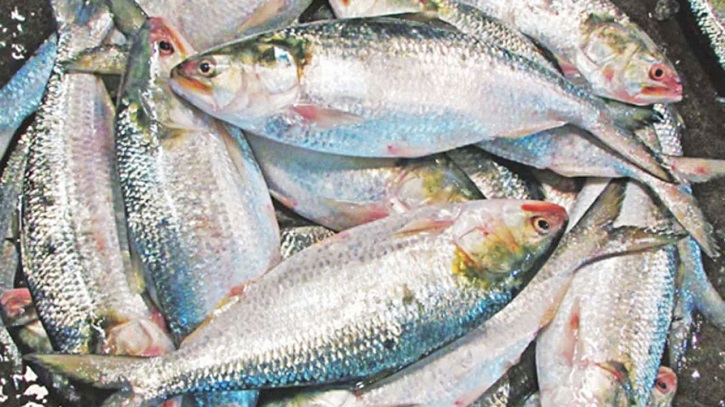
Despite the arrival of monsoon season, hilsa catches in the rivers and coastal waters of Barguna’s Patharghata upazila have been drastically low for nearly a month. Surrounded on three sides by the Bishkhali, Baleshwar, and Payra rivers, and bordered by the Bay of Bengal, the region's economy heavily depends on fishing—particularly hilsa. Yet this year, nature has not cooperated.
Local fishermen say hilsa should be abundant in the rivers by now, arriving in schools during the rainy season. However, since June 17, stormy seas and adverse weather conditions have prevented fishermen from venturing into deeper waters—where most hilsa are currently located.
Businessmen report a severe supply shortage in the markets. With demand outpacing supply, the price of large hilsa has surged, reaching over Tk 100,000 per maund (approximately 37 kg) in local markets. Both fishermen and traders say that prices could stabilize if the catch volume increases in the coming weeks. As the weather began to improve slightly, many fishermen resumed their efforts to go back to sea starting Thursday.
This fishing disruption has not only affected Patharghata but also impacted nearby upazilas, including Barguna Sadar and Taltali, as well as coastal areas in Pirojpur’s Mathbaria, Bhola’s Charfassion and Monpura, and several upazilas of Patuakhali—Kalapara, Rangabali, and Galachipa. For over three weeks, hundreds of trawlers have remained docked, unable to set sail.
On Friday, at the Char Doani Fish Landing Station in Patharghata, dozens of trawlers—including FB Mayer Doa, FB Halima, and FB Allah’r Dan—were seen preparing to return to sea. Fisherman Faizul Majhi, from FB Mayer Doa, shared that after the 58-day fishing ban ended on June 11, they attempted to resume operations on June 14 but were forced to return empty-handed due to worsening weather. “We’ve been stuck at the dock ever since,” he said.
According to the Meteorological Department, four low-pressure systems developed over the Bay of Bengal in the past 20 days, each causing maritime warnings and worsening sea conditions. The most recent was on July 7.
Trawler owner Abdul Malek explained that fishermen only had a three-day window after the fishing ban to go to sea before the weather turned again. Since then, strong winds and storms have kept them ashore for about 25 days.
Atiqur Rahman Ponir, supervisor of the Char Doani landing center, said ideal conditions for hilsa migration—light rain and easterly winds—have been missing. “The rivers aren’t getting the kind of rainfall and wind hilsa need to move upstream. That’s why we’re not seeing the expected catch in the Bishkhali, Baleshwar, and Payra rivers,” he said. Currently, daily catches barely reach 1 to 1.5 tons, compared to nearly four times that last year.
He added that in June this year, only 26 tons of hilsa were sold at the landing center, and just 10 tons so far in July. River-caught hilsa over 1 kg in weight are selling for up to Tk 110,000 per maund, compared to Tk 65,000 per maund for similar-sized fish caught in the sea.
Despite the current situation, fisheries officials advise patience. They believe that although the monsoon is in full swing, inadequate rainfall and southward winds in the deep sea are delaying the arrival of hilsa shoals near the coast. However, there is still time, as the peak hilsa season continues for several more months. If the weather becomes more favorable, better catches are expected in the coming weeks.





